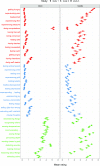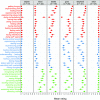Rethinking people's conceptions of mental life
- PMID: 29073059
- PMCID: PMC5664492
- DOI: 10.1073/pnas.1704347114
Rethinking people's conceptions of mental life
Abstract
How do people make sense of the emotions, sensations, and cognitive abilities that make up mental life? Pioneering work on the dimensions of mind perception has been interpreted as evidence that people consider mental life to have two core components-experience (e.g., hunger, joy) and agency (e.g., planning, self-control) [Gray HM, et al. (2007) Science 315:619]. We argue that this conclusion is premature: The experience-agency framework may capture people's understanding of the differences among different beings (e.g., dogs, humans, robots, God) but not how people parse mental life itself. Inspired by Gray et al.'s bottom-up approach, we conducted four large-scale studies designed to assess people's conceptions of mental life more directly. This led to the discovery of an organization that differs strikingly from the experience-agency framework: Instead of a broad distinction between experience and agency, our studies consistently revealed three fundamental components of mental life-suites of capacities related to the body, the heart, and the mind-with each component encompassing related aspects of both experience and agency. This body-heart-mind framework distinguishes itself from Gray et al.'s experience-agency framework by its clear and importantly different implications for dehumanization, moral reasoning, and other important social phenomena.
Keywords: agency; animacy; folk theories; mind perception; social cognition.
Conflict of interest statement
The authors declare no conflict of interest.
Figures




References
-
- Gray HM, Gray K, Wegner DM. Dimensions of mind perception. Science. 2007;315:619. - PubMed
-
- Gray K, Knobe J, Sheskin M, Bloom P, Barrett LF. More than a body: Mind perception and the nature of objectification. J Pers Soc Psychol. 2011;101:1207–1220. - PubMed
-
- Gray K, Wegner DM. Feeling robots and human zombies: Mind perception and the uncanny valley. Cognition. 2012;125:125–130. - PubMed
Publication types
MeSH terms
LinkOut - more resources
Full Text Sources
Other Literature Sources
Miscellaneous

